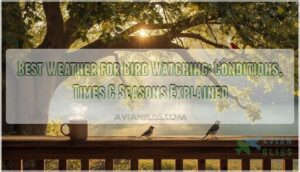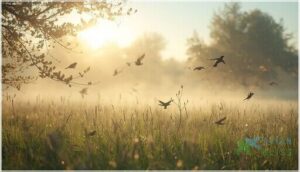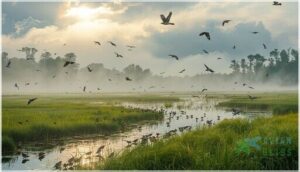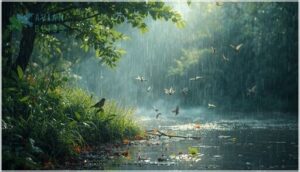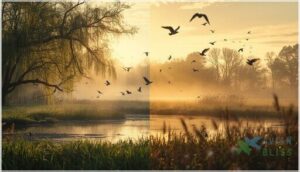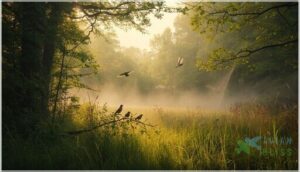This site is supported by our readers. We may earn a commission, at no cost to you, if you purchase through links.
You step outside at 7 a.m., coffee in hand, and the cardinal that usually announces itself from the oak tree is nowhere to be heard. Yesterday at the same hour, you counted six species before breakfast. The difference? Yesterday morning brought mild temperatures and a light breeze; today’s gusty winds and temperature drop have sent birds into shelter mode.
Weather doesn’t just set the mood for your outing—it fundamentally reshapes bird behavior, determining where they fly, when they vocalize, and how visible they become. Understanding these patterns transforms random sightings into predictable encounters, letting you time your observations when conditions align with peak activity and your target species are most likely to appear.
Table Of Contents
- Key Takeaways
- Ideal Weather Conditions for Bird Watching
- Best Times of Day for Bird Watching
- Seasonal Influences on Bird Activity
- Weather Impacts on Bird Behavior
- Strategies for Bird Watching in Varying Weather
- Frequently Asked Questions (FAQs)
- How do lunar phases affect bird behavior and visibility?
- How does altitude affect bird species and activity?
- Are foggy conditions beneficial for spotting certain birds?
- How does barometric pressure affect bird migration timing?
- Do birds behave differently during solar or lunar eclipses?
- What moon phases are best for nocturnal birding?
- How does air pollution reduce bird visibility and counts?
- Conclusion
Key Takeaways
- Weather shapes bird activity and visibility, with mild temperatures, light winds, and partial cloud cover offering the best conditions for spotting diverse species.
- Bird activity peaks early in the morning and again in late afternoon, with the dawn chorus and pre-roost gatherings as key times to observe the most birds.
- Seasonal shifts, like spring and fall migrations or irruptions in winter, dramatically alter which birds you’ll see and how they’re behaving.
- Adapting your birdwatching strategies to wind, rain, temperature, and shelter needs helps you find more birds and enjoy safer, more productive outings.
Ideal Weather Conditions for Bird Watching
For bird watching, the weather can make all the difference. The right conditions bring out the best in both birds and birders.
Here’s what to look for if you want to make the most of your time outdoors.
Mild Temperatures and Comfort Zones
When you’re planning a morning in the field, nothing shapes birding quite like mild temperatures. Most birds—and birders—thrive between 10°C and 21°C, where energy loss is low, activity peaks, and even the shyest species become visible.
Here’s what to watch for:
- Ideal temperature maximizes bird activity.
- Behavioral adaptations increase near comfort zones.
- Temperature fluctuations shift bird patterns.
- Observer comfort sharpens focus.
- Seasonal trends reveal new species.
To improve birding, consider how wind direction impacts bird migration.
Light Winds and Calm Air
If you want to boost your birdwatching results, aim for days with calm air and light winds. Birds spend less energy in flight when wind patterns are gentle, allowing foraging success to rise and survey accuracy to stay high.
You’ll notice more birds—especially songbirds—out in the open, making acoustic detection and migration safety much easier in these welcoming weather conditions. Unfavorable weather conditions can increase bird collision risk.
Fog, Mist, and Air Clarity
After calm air, morning fog and mist pose a different set of weather challenges for birding. Detection rates often dip, since Fog Navigation becomes risky, and birds stick closer to shelter. Mist Foraging declines, delaying daily activity.
Still, when fog lifts, Air Clarity surges, sharpening visual and acoustic cues—ideal atmospheric conditions for spotting those hidden behavioral responses you’d otherwise miss.
Partial Cloud Cover Vs. Clear Skies
Once the mist clears, partial cloud cover is most prominent. Compared to clear skies, these conditions mean fewer shadows, sharper visibility improvement, and longer spells of bird activity.
Expect:
- Increased Vocalization Frequency and survey accuracy
- Easier identification thanks to reduced glare
- Peak activity in feeding areas
- More consistent soaring migration patterns
- Higher likelihood of migratory departure
That’s ideal birding conditions in action.
Rain Showers and Post-Rain Activity
If you find yourself birding during rain showers, expect bird activity to dip—most species shelter, and foraging slows to a crawl. Yet, as soon as the rain passes, watch for the foraging rebound and sharper vocalization patterns.
Post-rain, population effects surface, nest vulnerabilities become obvious, and migration delays become more evident as birds rush to catch up on lost feeding hours.
Best Times of Day for Bird Watching
For bird watching, timing can make all the difference. Birds follow their own natural schedules, and knowing when they’re most active helps you see more.
Here’s what you can expect at different times of day.
Early Morning Peak Activity
Ever wonder why birdwatchers rise before the sun? Early morning marks a burst of bird activity—sunrise foraging isn’t just common, it’s critical for energy replenishment. During these high-alert hours, you’ll notice:
- Elevated species diversity
- Survey timing aligns with peak activity
- Birds actively feeding
- The engaging dawn chorus filling the air
The magic happens just after sunrise.
The Dawn Chorus Phenomenon
About an hour before sunrise, you’ll hear what ornithologists call the dawn chorus—a symphony where over 80% of bird species ramp up their singing. This temporal synchronization isn’t random; larger birds usually vocalize first, with chorus diversity peaking as light intensity increases.
About an hour before sunrise, the dawn chorus begins, with over 80% of bird species singing in a synchronized early-morning symphony
Acoustic monitoring reveals that environmental influences like temperature (r = 0.710) drive this striking bird behavior, making it the best time for birding and conservation applications worldwide.
Late Afternoon and Evening Patterns
As dusk approaches, you’ll notice birds shift into high gear—late afternoon foraging accounts for 46.3% of daily feeding as they stock up before nightfall. Watch for pre-roost movements and flocking behaviors intensifying within the last hour of light.
- Feeding peaks again around 4–5 pm, especially after rain showers
- Territorial dusk vocalizations reinforce boundaries in breeding seasons
- Swallows perform acrobatic insect-hunting flights between 5–7 pm
- Corvids gather in communal roosts, sometimes thousands strong
Cooler temperatures and low-angle light make these evening hours ideal for observing diverse avian behavior.
Seasonal Influences on Bird Activity
The rhythm of the seasons reshapes the birding landscape more than any other factor, determining which species you’ll encounter and how active they’ll be. Each season brings distinct opportunities, from the explosive energy of spring migration to the quiet patience required in winter months.
Understanding these seasonal patterns helps you align your birding trips with the most rewarding conditions throughout the year.
Spring Migration and Breeding Season
Spring migration transforms North America between March and June, with up to 500 million birds crossing the continent on peak nights. You’ll see the highest diversity in mid-May when breeding activity reaches its maximum.
Weather conditions directly influence migration timing and breeding success—warmer springs advance arrival dates, while late cold snaps can delay nesting and reduce clutch sizes for many songbirds.
Fall Migration Observations
Fall migration spans nearly half the year, peaking from late September through October. You’ll witness over 1.2 billion birds crossing the United States on record-breaking nights when calm tail winds and clear weather patterns align.
Species diversity peaks in September—warblers, thrushes, and sparrows move through coastal hotspots like Virginia’s Atlantic Flyway.
Conservation risks increase during adverse weather conditions, making timing essential for your observations.
Winter Birding Opportunities
Winter migrations bring unexpected rewards—North American bird species have shifted their ranges over 40 miles northward since the 1960s, creating opportunities at new locations. You’ll discover snowy owls during major irruptions, while coastal birding reveals massive waterfowl congregations exceeding 100,000 individuals. Despite snow conditions limiting some activity, winter weather offers easier viewing through bare branches. Winter feeders attract species you’d miss in other seasons, transforming frozen habitats into productive birding sites.
- Target Major Congregation Sites: Visit Gulf Coast regions or Florida refuges where shorebirds and waterfowl gather in winter.
- Monitor Irruptive Species: Track annual frugivorous bird movements through Christmas Bird Counts for rare sightings.
- Focus on Sheltered Feeding Areas: Position yourself near winter feeders and water sources during the coldest hours.
Summer Resident Birds
Summer season brings birds like Ruby-Throated Hummingbirds and Red-eyed Vireos to breed in North America, arriving April through May when temperatures and resources align. You’ll spot these summer residents in woodlands with native vegetation, where breeding success reaches nearly 70% in favorable conditions.
However, extreme heat increases mortality rates, with offspring survival dropping to just 31% during heat waves. Geographic distribution shows highest densities in eastern forests, where habitat usage peaks during the dawn chorus.
Weather Impacts on Bird Behavior
Weather doesn’t just determine your comfort in the field—it directly shapes what birds do, where they go, and how visible they become. Understanding these behavioral shifts helps you anticipate activity patterns and adjust your expectations throughout the day.
Let’s look at three key ways weather influences the birds you’re watching.
Feeding and Foraging Patterns
When temperatures fall below average, you’ll notice feeder visitation rates jump as birds seek reliable energy sources to offset increased energy expenditure. Breeding timing aligns closely with insect abundance—parents synchronize nestling care with post-rain prey booms.
Climate-driven shifts are reshaping habitat selection patterns, forcing species to adapt their foraging strategies. Understanding these ecological factors helps you anticipate where birds will concentrate their feeding efforts under varying weather influences on bird behavior.
Vocalizations in Different Weather
Bird behavior includes distinct vocal adjustments to weather conditions for birding. Temperature effects on song amplitude can increase by up to 21%, helping you hear distant bird species more clearly.
Rains impact communication drastically—rainfall reduces detectable calls by 15–32%, while winds influence vocal transmission, dropping detections by 22% on breezy days. Fogs propagation cuts call distance by 30%, though seasonal adaptations keep communication effective during breeding periods, supporting successful ornithological research and weather-aware birdwatching strategies.
Shelter-Seeking During Extremes
During severe weather conditions for birding, you’ll notice fascinating shelter-seeking behaviors that reveal favorable birding conditions even in extremes. Storm shelter choices include dense shrubs and tree cavities, where chickadees and sparrows huddle together.
Cold weather adaptations like fluffed feathers trap warmth, while heat wave havens offer shaded microhabitats.
Understanding these energy conservation strategies and hurricane refuge patterns enhances your birdwatching success across all bird behavior and habitat scenarios.
Strategies for Bird Watching in Varying Weather
Mother Nature doesn’t always cooperate with your birding plans, but that doesn’t mean you should pack up and head home. With the right strategies, you can turn less-than-ideal conditions into productive outings.
Here’s how to adapt your approach when the weather throws you a curveball.
Finding Sheltered Observation Spots
When weather conditions for birding turn rough, finding the right shelter makes all the difference in your wildlife observation success. Here’s how to choose sheltered observation spots that minimize bird disturbance while maximizing observer comfort:
- Use Natural Screens: Forest edges and vegetative cover reduce your visibility without causing habitat degradation through construction.
- Seek Built Structures: Public lands often feature hides, blinds, and elevated platforms designed with careful placement strategies.
- Position Wisely: Leeward slopes and dune bases offer natural protection while keeping you within ideal viewing range.
Proper shelter design enhances birdwatching by extending your observation time and reducing behavioral changes in sensitive species.
Adapting Techniques for Wind and Rain
When conditions get rough, adjusting your birdwatching techniques keeps observations productive. Rain gear extends your field time by an average of 42 minutes during steady showers, while waterproof optics prevent fogging issues. In windy weather, shift focus to seawatching productivity—onshore winds above 15 knots bring pelagic species closer. Target shorebird activity during rain showers, as waterbirds show 60–80% higher activity than songbirds.
| Weather Condition | Best Target Species | Detection Rate Change |
|---|---|---|
| Wind >16 km/h | Raptors, seabirds | Songbird detection drops 50% |
| Steady rainfall | Shorebirds, waterbirds | Activity increases 60–80% |
| Onshore winds >15 knots | Pelagic species | Seawatching improves 35% |
Adapting equipment and expectations to rainy weather and wind observation spots transforms challenging conditions into specialized opportunities for weather and birding success.
Choosing Optimal Days for Birding
Planning your outings around stable weather patterns can boost your success dramatically. Forecast accuracy helps you target post-frontal days, which deliver a 34% spike in rare species sightings.
Choice birdwatching conditions align with these three meteorological events and birdwatching strategies:
- Temperature sweetspot between 10°C and 21°C yields 42% more species
- Barometric pressure stability increases migratory activity 19%
- Weather influences on bird behavior peak after frontal passages
These choice birding conditions transform ordinary outings into memorable encounters.
Safety and Comfort Tips for Birders
You’ll get the most out of your outdoor activities when you pair UV protection—hats and sunscreen reduce skin cancer risk by 13%—with solid hydration strategies.
Carry 1.5 liters of water for half-day sessions, preventing the 10% performance drop after 90 minutes.
Waterproof boots cut sprain risk by 33% for terrain navigation, while your first aid kit and weather awareness apps round out essential birdwatching tips for birders.
Frequently Asked Questions (FAQs)
How do lunar phases affect bird behavior and visibility?
Who knew you needed a moon calendar to chase feathered friends? Nocturnal birding reveals that lunar migration patterns surge during full moons, when foraging activity doubles and vocalization patterns intensify, though species variability affects individual responses to moonlight.
How does altitude affect bird species and activity?
You’ll find more bird species below 300 meters, where richness peaks at over 20 species per transect. As you climb higher, habitat heterogeneity shapes ecological conditions, and feeding guild peaks shift mid-elevation.
Are foggy conditions beneficial for spotting certain birds?
Fog birding benefits surprise many observers—light morning fog lowers flight patterns, amplifying auditory birding cues as songbirds vocalize more.
Waterbird concentration increases near accessible edges, while post-fog activity often produces remarkable birdwatching during these meteorological events.
How does barometric pressure affect bird migration timing?
Rising barometric pressure acts as a departure trigger for migratory birds, signaling fair weather ahead. Synoptic-scale patterns structure migration timing, with high-pressure systems creating favorable conditions.
Individual responses vary by species, age, and population, while pressure-based tracking technologies now enable precise monitoring of these meteorological factors influencing bird migration patterns.
Do birds behave differently during solar or lunar eclipses?
Yes, birds behave differently during eclipses. During solar eclipses, many species increase vocalizations and display evening routines, while lunar eclipses trigger flight adjustments in nocturnal birds, affecting altitude and foraging patterns.
What moon phases are best for nocturnal birding?
Imagine the moon as a lantern guiding both birders and birds. Nights with half-moon or brighter phases boost lunar foraging, spark migration timing, and improve predator avoidance. Moonlight intensity fosters behavioral adaptation in nocturnal ornithology.
How does air pollution reduce bird visibility and counts?
Air pollution clouds the air, blocking sight lines and making bird counts unreliable. Count reductions happen as species sensitivity varies; smaller birds and certain colors become harder to spot, especially under shifting environmental influences and seasonal effects.
Conclusion
How often do you find yourself wondering why birds vanish or suddenly gather in force? The best weather for bird watching isn’t just about sunshine or cloud cover—it’s about reading the air and meeting birds on their terms.
When you match your outings to their daily rhythms and weather-driven behaviors, every walk transforms into a dialogue with the natural world. Step outside, and you’ll start to recognize patterns that once seemed like a string of lucky breaks.
- https://www.martinselkonen.fi/en/what-weather-conditions-favor-birdwatching/
- https://pmc.ncbi.nlm.nih.gov/articles/PMC11254321/
- https://bwdmagazine.com/adventures-in-birding/traveling-for-bird-watching/the-best-time-to-go-birding/
- https://fatbirder.com/weather-and-tides/
- https://www.birdforum.net/threads/how-bird-activity-is-affected-by-weather-conditions.397881/

